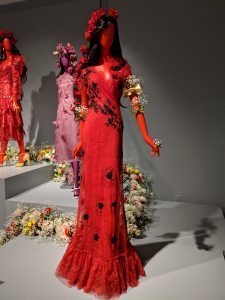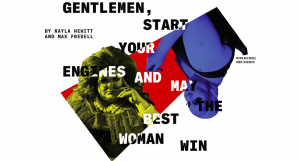Modern hipsters enter a thrift store looking to repurpose grandma’s Christmas sweater from ’73 into a high-fashion statement of individualism and irony.But every friend of said hipster is also a hipster, complete with their own version of grandma’s Christmas sweater from some decade recognizable by its experimental haircuts. If grandma’s Christmas sweater ceases to be original because everyone is wearing it, how can we continue to call this fashion choice “unique”? In other words, at what point are we mistaking individuality for conformity?
The unconscious of today’s college-aged youth is encompassed by archetypes like individuality, performativity, irony, and counterculture. Often, this demographic is dubbed “hipster” or “alternative” for its tendency to deconstruct and challenge mainstream culture through its members’ unique personal identities. Thrift shopping, specifically, is one area where today’s youth subconsciously fulfill these archetypes in pursuit of self-expression. The curation of thrifted fashions, however, also creates a paradox surrounding individuality as opposed to conformity: it seems like the movement towards individuality is actually becoming mainstream.
This contradiction is referred to in psychology as the myth of consumer sovereignty, where fabricating an “authentic” identity through thrifted items is just an illusion disguising the commonplace behavior of youth today in the hipster marketplace.
What’s more is that most young people who thrift don’t define themselves as hipsters. They are aware of their own tendency to conform but are still so convinced of their individuality that they reject fitting within a certain label. In the words of science writer Jeff Wise, “hipsters’ problem is that their purchases tend to place them in a category whose mythology they despise.” To understand the futility of their efforts to be an individual while attempting to appear as one, hipsters adopt a sort of cognitive dissonance, which allows them to keep up their consumer behavior while separating it from the perceived core of their character. This contradiction illuminates the fallacy of the hipster, in which youth today unconsciously look to secondhand clothing stores to curate the illusion of individuality.
This oddity also extends to the stores themselves. Curated thrift stores—in which the selections are handpicked, as opposed to Goodwill or The Salvation Army—appeal in particular to the aesthetic principle of why young people thrift. But in doing so, they become the opposite of what thrift stores are meant to be: an affordable option for people in need. This paradox especially applies to college kids who can afford to shop at more expensive stores, but instead opt for used clothing to rack up social clout. Hipster culture and the way it values vintage disincentivizes youth from shopping from corporate brands, instead persuading them to wear thrifted looks for all the wrong reasons. Sociologist Karen Hanlon coined the term “poor chic” to describe the fads and styles in popular culture that romanticize poverty and the traditional symbols of the working class. This trend borders on exploitative when it creates a spectacle of what remains a necessity for others.
The more curated these stores get, the more expensive and further from authentic they become. Technically there are no official “thrift” stores left in Georgetown; only consignment shops remain, which are for-profit resale businesses. The Buffalo Exchange on M Street was a highly successful branch of its consignment store chain before it closed in October 2016 due to rent issues. Ella-Rue and Reddz Trading feature more high-end designer clothing for those with bigger budgets. Regardless, students and other young people are willing to pay more for vintage items branded as novel, when the same items are being mass-produced by commercial chains next door. In the spirit of absurdism, we assign more meaning and thus more merit to the thrifted grandma’s Christmas sweater simply because of the “vintage” history attached to it—because it’s fun to feel retro. Flashbacks are fashion-forward, yet the average consumer stands distant from the histories woven in with every thread.
Students come and go, and so does the stylistic ethos of Georgetown. The kinds of fashion offered on M Street have been in flux over the decades. The ’90s marked a clear departure from the independent, mom-and-pop stores and boutiques to a wave of corporate brands. With that, the cultural identity of Georgetown was redefined within the greater D.C. scene as less “cool,” despite its potential for hip student influence.
Curated thrift stores are equally paradoxical to “individual” hipsters themselves for attempting sovereign identities amid the bandwagon of conformity. From interpreting friendships based on Myers-Briggs types to reading daily horoscopes, youth today are culprits of deception, constructing false realities in order to feel a sense of continuity among the absurdity of it all.





Fantastic piece!